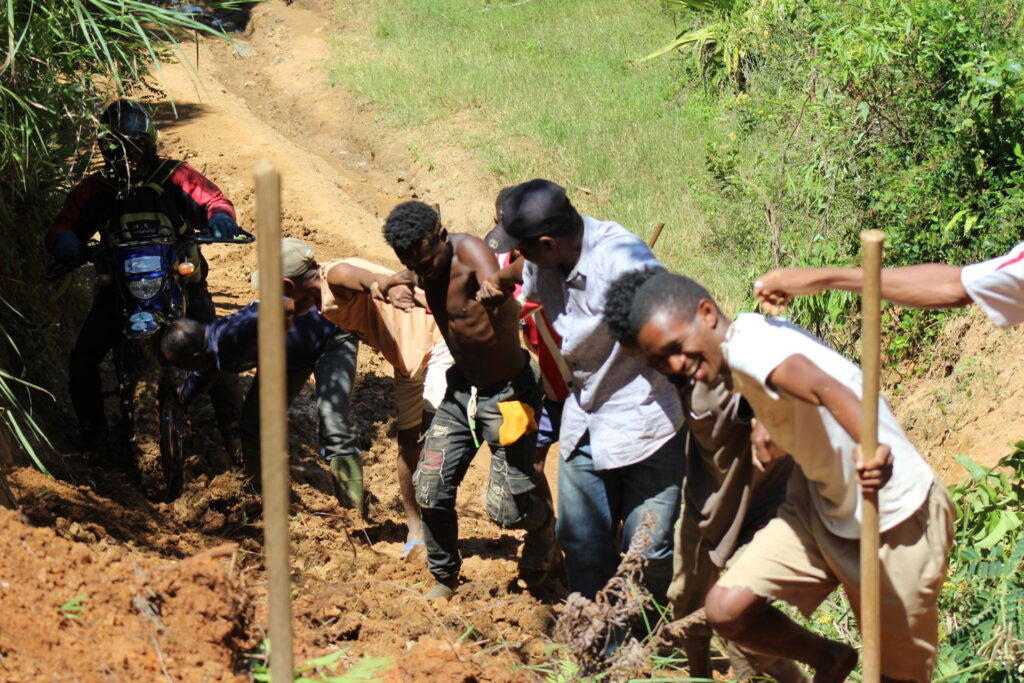If you told me I would take a fifteen-hour bus ride followed by two separate five-hour motorcycle rides (walking the bike and pushing it through the mud half of the time) in order to see the world’s rarest duck in its natural habitat, I would say yes, of course, that sounds like something I would do. If you told me I would actually get the chance to do it, then I would call you crazy. Or maybe I would call myself crazy like the rest of the passengers on the bus did when they asked me where I was headed and why.
I was on a pilgrimage to see ganagana fotsimaso, the legendary white-eyed duck or Madagascar Pochard, once declared extinct but now came back from the dead and still paddling.

But I would have three days of travel to get there first. Through the window, mountains and valleys were crisscrossed by alternating lines of green and red like the veins and arteries of the hills. The landscape lost its color and edges by night but glowed strangely bright under the full moon. Drifting in and out of sleep, I would be suddenly shaken awake by the jarring movement of the bus and look out the window to see what looked like a desolate moonscape. We were passing the Betsiboka River, harsh and ominous under the moonlight, but just as sinister by day. In the rainy season, the river runs completely red with sediment rushing in and overflowing its banks. Around four in the morning, the driver stopped for a smoke break and I blearily stumbled out of the bus. All around me the glowing tips of the passengers’ cigarettes flickered like tropical fireflies.
By the end of the bus ride, I was slightly delirious. I’m pretty sure I heard the guy behind me throw up into a plastic bag and hand it to the person next to him (thankfully not me) to toss out the window. Then we finally pulled into Antsohihy, the first stop on my way to Bemanevika.

The next day, I felt like I was in an action movie. As soon as I hopped onto the motorcycle, Perlan the driver wordlessly handed me his phone. When I asked who it was, his only reply was, “It’s the Professor.”
Lily, Professor Rene de Roland, head of the Madagascar chapter of the Peregrine Fund, a soft-spoken, fatherly-looking man with a comical amount of authority in this region. Anytime I had my doubts about getting permission to do the study or to travel through the protected area, everyone would tell me to say I was Lily’s student and all my problems would go away. It’s gotten me this far already. A personal motorcycle escort to the research camp during the rainy season when the usual buses that travel these roads don’t dare venture out without three spare tires.
He wished me safe travels and a successful mission over the phone, and as soon as I hung up we took off down the dirt road. The drive started out fine enough. We swerved in between herds of zebu, pedestrians, and infinite potholes. It seemed like just about everyone in town was out that day for a picnic, and everyone who owned a zebu had it hitched to a cart pulling a massive rock concert-sized speaker blasting dance music into the poor animal’s ears.
Unsurprisingly, things only continued to get stranger. The road narrowed and flooded until we were driving through what looked like irrigation ditches between rice fields. When we got to the river, at least twenty feet across to the other side, I thought surely we were going to get off and walk around. That’s when I learned that motorcycles work even when underwater. Half-kneeling, half-squatting, I looked like an overgrown bird perched on the motorcycle seat as we plunged into the river. At one point, the bike was submerged up until the speedometer yet the engine kept on sputtering and gurgling from underwater.

Somehow, we made it to the campsite. That’s when my real work began.
Bemanevika is the only place in Madagascar, and in the world, where the pochards live in the wild. There’s another lake in the region where NGOs are attempting to release captive-bred pochards in case the Bemanevika population declines, yet these birds are still provided with food and are heavily reliant on humans. For the next two weeks, I would be hiking to two of the Bemanevika lakes to observe pochard behavior and make a complete population count.

If this sounds easy, sitting in a boat or on an observation platform all day and watching ducks swim around, let me tell you that it was nearly impossible to find a single bird through my binoculars that first day. I would scan the reeds and papyrus in the distance and say with confidence that there were no sleeping or hiding ducks. Yet when one of the other technicians took up their binoculars, they would find five or six that I’d missed every time.
I fall into a comfortable routine of waking up before dawn, huddling around the campfire to scarf down a breakfast of rice and ramen noodles, then hiking out to the lake with my notebook and a pair of binoculars. Somedays I miss the convenience of a big city like Tana, or the reliability of seeing the other students every day and talking about what new food we tasted for the first time at dinner or how many geckos we saw crawling on our walls last night. Whenever something crazy happens, I remember to tell my friends all about it when I get back.
But for now, the ducks are there waiting for me to find them.
